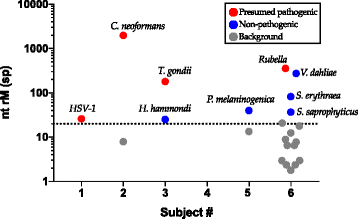Illuminating uveitis: metagenomic deep sequencing identifies common and rare pathogens
- PMID: 27562436
- PMCID: PMC4997733
- DOI: 10.1186/s13073-016-0344-6
Illuminating uveitis: metagenomic deep sequencing identifies common and rare pathogens
Erratum in
-
Erratum to: Illuminating uveitis: metagenomic deep sequencing identifies common and rare pathogens.Genome Med. 2016 Nov 22;8(1):123. doi: 10.1186/s13073-016-0377-x. Genome Med. 2016. PMID: 27876088 Free PMC article. No abstract available.
Abstract
Background: Ocular infections remain a major cause of blindness and morbidity worldwide. While prognosis is dependent on the timing and accuracy of diagnosis, the etiology remains elusive in ~50 % of presumed infectious uveitis cases. The objective of this study is to determine if unbiased metagenomic deep sequencing (MDS) can accurately detect pathogens in intraocular fluid samples of patients with uveitis.
Methods: This is a proof-of-concept study, in which intraocular fluid samples were obtained from five subjects with known diagnoses, and one subject with bilateral chronic uveitis without a known etiology. Samples were subjected to MDS, and results were compared with those from conventional diagnostic tests. Pathogens were identified using a rapid computational pipeline to analyze the non-host sequences obtained from MDS.
Results: Unbiased MDS of intraocular fluid produced results concordant with known diagnoses in subjects with (n = 4) and without (n = 1) uveitis. Samples positive for Cryptococcus neoformans, Toxoplasma gondii, and herpes simplex virus 1 as tested by a Clinical Laboratory Improvement Amendments-certified laboratory were correctly identified with MDS. Rubella virus was identified in one case of chronic bilateral idiopathic uveitis. The subject's strain was most closely related to a German rubella virus strain isolated in 1992, one year before he developed a fever and rash while living in Germany. The pattern and the number of viral identified mutations present in the patient's strain were consistent with long-term viral replication in the eye.
Conclusions: MDS can identify fungi, parasites, and DNA and RNA viruses in minute volumes of intraocular fluid samples. The identification of chronic intraocular rubella virus infection highlights the eye's role as a long-term pathogen reservoir, which has implications for virus eradication and emerging global epidemics.
Keywords: Metagenomic deep sequencing; Pathogen discovery; Rubella virus; Uveitis.
Figures



References
-
- Endophthalmitis Vitrectomy Study Collaboration. Results of the Endophthalmitis Vitrectomy Study. A randomized trial of immediate vitrectomy and of intravenous antibiotics for the treatment of postoperative bacterial endophthalmitis. Endophthalmitis Vitrectomy Study Group. Arch Ophthalmol. 1995;113(12):1479–96. - PubMed
Publication types
MeSH terms
Grants and funding
LinkOut - more resources
Full Text Sources
Other Literature Sources
Research Materials
Miscellaneous

